Economy Revised 11/21

An employee at Olympia local business, Olykraut.
What Olympia Values:
Olympians recognize the value of a healthy economy that is stable and sustainable. The health and welfare of the community depends upon there being a range of employment opportunities so that we are not dependent on just one sector for our economic welfare. Local businesses should have access to quality infrastructure so that they have what they need in order to engage in commerce. Community Members should have access to a broad range of locally produced goods and services so that they can be assured that their money is spent in ways that sustain our community. Our community should continue to be an active center for arts and recreation – and grow and foster their development. Education and health care are also critical to a stable and sustainable economy – our community is graced with several premier institutions in each of these sectors and we collaborate with them on projects of mutual benefit.
Our Vision for the Future:
Olympia’s economy is diverse and balanced. Family wage jobs and career opportunities are available to our community members from multiple sectors, including government and manufacturing, health care, education, and service sector employment. A significant and ever increasing amount of our goods, services and food is locally sourced. We emphasize sustainable business practices and environmentally friendly development.
Read more in the Community Values and Vision chapter
Introduction
The strength of Olympia’s economy is what determines whether we are able to pay for the public services that help to make our community a great place to live. A diverse and healthy economy provides a reliable tax base that generates revenues sufficient to keep pace with inflation. The quality of the community is the most powerful economic engine we have for attracting and maintaining high quality job opportunities.
We have been told by Olympians they value an economy where:
• There are plentiful living-wage jobs.
• Consumers and the City support local entrepreneurs.
• Residents and businesses want many of their goods and services to come from local sources.
• A highly educated workforce, entrepreneurial spirit and culture of innovation energize our economy.
• Art projects, art events, and support for the arts are integral to the community and its economy.
A healthy economy must provide jobs that pay a living wage, usually defined as a wage that allows a household to meet its basic needs without the need for public assistance. The level of a living wage will vary based on the size and makeup of the household.
See the links in the “For More Information” section at the end of this chapter for more information about what constitutes a living wage in our community, cost burdened households and middle income housing affordability.
Olympia’s Economic Profile
Cities play a critical role in supporting local economic activity. Without municipal services, economic activity and development is simply not possible. In turn the commerce that takes place in our community is responsible for much of the revenue that the City receives by way of taxes and fees that are used to help to support our quality of life. In the economic development arena, Olympia has the following roles:
• Using its land-use authority to provide places for businesses to locate.
• Maintaining an efficient, fair, transparent, and predictable permitting process that reduces business-cost and timeline uncertainties.
• Collaborating with other public and private entities that have a more direct role in economic development, such as ports, business associations, and economic development associations.
• Developing and maintaining the infrastructure healthy businesses and neighborhoods need.
• Investing in traditional infrastructure, such as roads, sewer and water service, as well as in schools, parks, arts, and the natural environment.
• Commissioning reports, such as the “2013 Investment Strategy: Olympia’s Opportunity Areas” and the Downtown Olympia “Community Renewal Area Feasibility Study,” to provide information for the community to make informed decisions about its economic future.
Olympia’s Three Top Employers:
Government:
Olympia is the capital of Washington and seat of Thurston County. The State, County, and City provide many local jobs. Government was the largest employer in Thurston County in 2010, contributing nearly 36,000 jobs. The Olympia School District is one of the largest single employers within the City. Many of these government jobs are tied to our more diverse, statewide economy, which helps to shield our community from economic swings. However, fluctuations in state government affect our local economy.
Given that our state’s population is projected to grow significantly, it is very likely that employment with the state of Washington will continue to contribute in a positive way to our local economy in the long-term. State employment helps to sustain our skilled and well educated workforce, which in turn provides an attractive labor force for private sector companies to draw from as they make decisions about where to locate.
The state has also been moving away from leasing private space to house its employees. A new 200,000 square foot office building is in the planning stages for the Capital Campus block located at the northwest corner of Capitol Way and 11th Avenue. This will likely mean that there will continue to be an excess of office space available for rent in the greater Olympia area. Other issues like school funding mandates may also impact the size of the State’s workforce and its leasing practices.
The Investment Strategies report calls out that almost a third of state government employees statewide (32%) are over 55 years of age. As these employees retire over the next decade, many of those positions will likely be filled with younger employees. This trend could impact the demand for residential housing within Thurston County, regardless of the overall size of state government. A younger state workforce could likely lead to a higher demand for multifamily housing that is supported by transit. Data from the Thurston Regional Planning Council’s Sustainable Thurston report suggests that the “millennial” generation prefers urban multifamily housing options over suburban life styles. The changing demographics of Olympia’s workforce will impact the City in several ways. There will likely be a demand for more downtown multifamily housing as millennials seek housing near their place of employment. Also, a retiring workforce will likely lead to the need and interest in more downtown multifamily housing, senior services and senior-oriented activities. These changes provide opportunities for quality growth in our future.
The Olympia School District is another significant governmental employer with approximately 1,300 employees providing K-12 education to approximately 9,000 students. The school district’s Capital Facility Plan includes over $178,000,000 in construction projects and another $11,680,000 in small works projects. The Olympia School District’s operating budget is over $92,000,000. Future plans include a new middle school in Southeast Olympia.
Health care:
Olympia is also a regional medical center, serving Thurston, Mason, Gray’s Harbor and Lewis counties. Health care is the Thurston County’s second largest employment sector, with an estimated 11,595 jobs and is projected to continue growing in the future.
Retail:
Olympia’s shopping mall, auto mall, and downtown business core make it the region’s largest retail center, providing significant sales tax revenue. Retail provides an estimated 11,076 jobs in 2010 and is the county’s third largest employment sector. However, unlike our government and health care employers, retail provides an average living wage that is just under what the City estimates is needed for a single adult in Olympia.
The Investment Strategy report adds, “The City of Olympia is projected to accommodate an estimated additional 18,000 jobs by 2035. Of those, almost 75% of new jobs in Olympia will be in commercial sectors. Jobs in industrial sectors (10%) and government (15%) will make up the remainder of new employment. Countywide, the sectors with the largest forecasted new jobs are professional and business services. However, Thurston Regional Planning Council’s forecasts have construction employment growing substantially with total construction employment more than doubling by 2040 from 5,620 in 2010 to 12,700. Manufacturing employment is also forecasted to increase but at a much slower rate adding about 500 jobs from 2010 to 2040.”
The Port of Olympia
Olympia is also the only city in Thurston County with a deep water harbor. The Port of Olympia operates a marine import and export terminal, the largest recreational boating marina on South Puget Sound, and a state-of-the-art boatyard. The Port is also the home of many private, marine-related businesses, the Batdorf & Bronson Roasting House, the Olympia Farmers’ Market, and many professional offices and retail businesses.
Among our partners in economic development, the Port of Olympia has the closest relationship to Olympia’s economy, and its mission is to grow the Thurston County economy, move people and goods, and improve the County’s recreation options and environment. The Port is a special-purpose district, and its boundaries are the same as Thurston County’s.
The Port owns 200 acres along Budd Inlet near Olympia’s central business district. The Comprehensive Scheme of Harbor Improvements, the Port’s development plan for its Olympia properties, includes industrial uses in the vicinity of the Marine Terminal, recreational boating uses at the Swantown Marina and Boatyard, and mixed uses in the Market, North Point, and East Bay Districts. Recreational uses are envisioned throughout its mixed-use districts and the Marina. For example, the East Bay District is a significant investment and downtown redevelopment opportunity, home to the Hands On Children’s Museum and East Bay Plaza.
Although a smaller factor in our local economy than state government, the Port’s potential is significant and gives the City an opportunity to further diversify its economy.
Education, Entertainment, and Geography
Olympia is the region’s restaurant, art, and entertainment center. There are three nearby colleges, The Evergreen State College, St. Martin’s University, and South Puget Sound Community College, which have a major impact on the culture of our community and our high average level of education.
As a result of The Evergreen State College, the City of Olympia has become home to many innovative entrepreneurs and artists that were originally attracted to our community to go to school. Evergreen is widely acknowledged as one of the nation’s premier liberal arts institutions and its location here provides an opportunity for continued and expanded collaboration on entrepreneurial development. Evergreen hosts three masters programs – in public administration, teaching and environmental studies. Each of these programs provides an opportunity to collaborate with the college to attract and foster complementary research and development activities. Our community serves as a learning laboratory for students and potentially an international destination for learning and cultural exchange. The City should continue to seek opportunities for direct partnerships with the college on program development, capital facilities planning and student housing. A physical presence in our downtown could create opportunities for both the City and the College
In addition, Olympia is well-served by its highway network, which includes Interstate 5 and Highway 101, with links to State Route 8 and the Olympic and Kitsap Peninsulas. All of this means Olympia’s location provides easy access to a variety of recreational opportunities - from bike trails and kayaking within our city limits, to skiing and hiking in the mountains, to beachcombing along the coast and regional customers for the area’s retail businesses and health care providers.
Thurston County benefits from regional economic growth and activity in the Puget Sound region that filters down to the County as the region grows. Joint Base Lewis-McChord has increased demand for housing in the region, particularly in Lacey.
There are growing signs of an urban infill market in Olympia in part driven by a changing demographic oriented towards urban living. In the last ten years, most recent building activity in Olympia has focused on rehabilitation or remodeling of existing space with limited new development. As growth has rebounded, multifamily development has been the first sector to recover. Builders are taking advantage of sites that are easily developable and/or high amenity areas. Continued population growth in the region will generate demand for additional housing and commercial services, such as general services, retail, and health care. To be competitive Olympia must understand the strengths and weaknesses of its market.
A Healthy Economy Enhances our Quality of Life
Olympia enjoys a relatively healthy economy and stable revenue base, making it possible for it to invest in public improvements and services. These include the Washington Center for the Performing Arts, The Olympia Center, Percival Landing, the Farmers Market, new sewer capacity, new roads, and other needed infrastructure. All of this makes Olympia increasingly attractive to private investors, which will further increase our revenue base, and make more community improvements possible. However, the City should not make these sorts of investments without also considering the long-term maintenance and operations costs it will also incur.
Downtown Olympia
Downtown Olympia is a special place. For many years it has served as Thurston County’s only downtown. It has the only urban waterfront in the region, attracting recreational boaters from throughout Puget Sound. It has the only performing arts center, is the region’s banking sector and is the recreational hub for the region.
Downtown Olympia is also home to the state’s largest farmers operated farmers’ market. The Olympia Farmers’ Market serves as a link to a substantial network of small family-owned farms and businesses. The market serves as a tourist attraction and destination and a place for local residents to purchase local food. Farmers Markets have proven to be a good way to foster the development and expansion of locally owned businesses. In recent years small neighborhood markets are beginning to appear in Olympia with the hope of fostering more neighborhood centers and even more accessibility to locally grown and produced products.
Thursday, Friday and Saturday evenings see the streets of downtown come alive with theater patrons, diners and live music fans. Recent enhancements such as the Hands on Children’s Museum, East Bay Plaza, LOTT Clean Water Alliance’s WET Center and Percival Landing reconstruction add to downtown’s status as a destination.
The proximity of the Capital Campus to downtown creates a strong relationship between the campus and downtown that is enhanced by the presence of the Dash Shuttle, an Intercity Transit bus that operates on 10 minute headways. This free link between the downtown and the state campus is helpful for downtown commerce and a convenience to workers and visitors that come to Olympia to participate in the State Legislative sessions.
Downtown remains a work in progress and the City has invested heavily from both a capital facilities and services perspective. From 2012 to 2014 the City has used an action oriented program known as the Downtown Project to effect change. The Downtown Project has included key elements such as enhancing the downtown walking patrol, replacing parking pay stations, creating a Downtown Ambassador program, establishing an Alcohol Impact Area, and construction of parklets to name just a few.
The City has initiated a Community Renewal Area (CRA) planning process for downtown. The Community Renewal Area law was created by the state specifically to give communities the tools that they need in order to help areas such as the downtown move forward. Washington law (RCW 35.81) allows cities to establish a Community Renewal Area through the designation of a geographic area that contains blight and the creation of a Community Renewal Plan for addressing that blight. Many Washington cities have used CRA to develop and implement redevelopment plans, including Vancouver, Shoreline, Everett, Bremerton, and Anacortes.
Olympia’s downtown is the urban center for the entire region - residents and business owners would all benefit from a more active, vibrant downtown. However, parts of downtown are widely recognized as “blighted”, with several condemned or obsolete buildings occupying key properties. Soil contamination, excessive amounts of surface parking, soils subject to liquefaction and rising seas also contribute to the blight. Redevelopment is stuck despite the area’s unparalleled assets. The City has an interest in improving the downtown and enhancing its economic productivity in a manner consistent with the rest of this plan. The creation of a CRA may be one way to accomplish this objective.
In 2013 the City initiated an economic development planning process to consider creating a Community Renewal Area in downtown and to provide an assessment of the broader real estate market. This process resulted in the preparation of two key reports: “Investment Strategy: Olympia’s Opportunity Areas” and the Downtown Olympia “Community Renewal Area Feasibility Study”. These reports will help to refine the City’s approach to economic development over the coming years and underpin the City’s Community Renewal Area planning process.
The Investment Strategy report provided a community wide assessment of key redevelopment opportunity areas. In addition to downtown, six geographic areas were examined in detail:
• Kaiser/Harrison - Potential for neighborhood commercial/mixed-use/retail district on large single-ownership tract;
• Olympia Landfill - City-owned, potential major retail site adjacent to existing major retail area;
• Division/Harrison - Potential neighborhood center adjacent to established neighborhoods;
• Headwaters - Large multi-ownership parcel with wetland amenity and infrastructure challenges;
• K-Mart Site - (currently vacant) on major close-in retail corridor.
Downtown Focus Area for Community Renewal Area Planning
The Investment Strategy report recommends that the City manage its development area assets as a portfolio that adheres to the community vision. This approach includes: (1) strategically investing in infrastructure improvements, such as roadways, streetscape improvements, and property acquisition; (2) making necessary or desired regulatory adjustments, such as zoning changes; and (3) creating partnerships with developers and property owners to generate development returns that remain sensitive to market demand.
The CRA Feasibility Study provides the outline and support materials for the ultimate creation of a CRA in Downtown Olympia.
Key findings related to downtown from the Feasibility Study include:
• Demand from those users who need to be downtown (such as state government, the Port, and related uses) is not a growing part of the economy.
• The redevelopment hurdle downtown is higher than other locations because of higher land and construction costs.
• Commercial rents are not yet high enough to justify new commercial construction in Downtown Olympia.
• Office rents have decreased as vacancies have increased.
• Retail rents are more stable, but have also decreased.
• Low vacancy rates and modest rent increases for apartments citywide, as well as some anecdotal evidence suggest that there is near-term demand for multifamily housing.
• Over $100 million of public investment has been made downtown by the City and Port of Olympia in new buildings and parks, including a new City Hall, the Hands On Children's Museum, LOTT Clean Water Alliance offices, East Bay Plaza, and Percival Landing.
Although these public facilities help to improve our quality of life, public facilities cost money to operate and maintain. Unless they directly contribute to commerce they become a burden and are difficult to sustain within the City’s general fund budget. In order to protect and enhance our quality of life it will be critically important for the City to make public investments and form public private partnerships that increase commerce in ways that are consistent with the community’s values. The City should not make these sorts of investments without also considering the long-term maintenance and operations costs it will incur.
Supporting Revenue Sources
Olympia General Fund Revenues
Per Capita
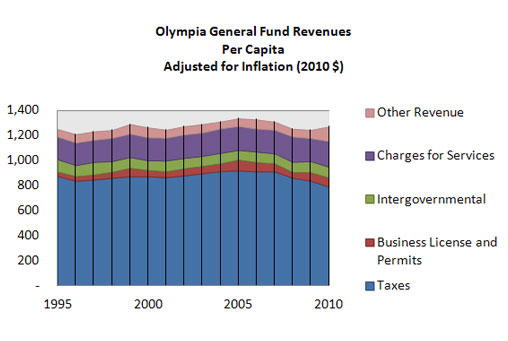
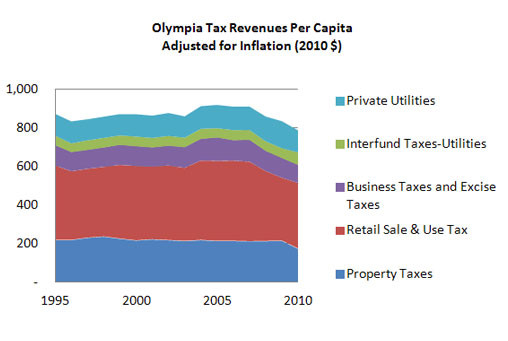
Olympia’s revenue comes from a mix of taxes and fees. The Olympia General Fund Revenues Per Capita table shows the sources of the City’s General Fund revenues, over the last 15 years on a per capita basis. Olympia’s largest revenue source is taxes, which represents well over half of the General Fund’s revenue. The Olympia Tax Revenues Per Capita table provides a breakdown of taxes by various categories. Significant tax revenues come from commercial hubs such as the auto mall and regional shopping areas, construction and construction related industries.
While taxes on a per-capita basis have generally increased during the last few decades, our revenue from sales, business and property taxes fluctuates with the economy. Revenue from sales tax falls when consumers spend less. The property tax we collect per capita falls when property tax levies don’t keep pace with population growth. In recent years property de-valuation has constrained the City’s capacity to incur debt. Finally, property taxes have been limited by Initiative 747, passed by Washington voters in 2001, which limits growth in property tax revenue to 1 percent per year. This is a rate that generally lags well behind the increasing costs of providing those services. According to the Bureau of Labor Statistics the consumer price index for the western United States has averaged 2.27% for the past 10 years.
Major City services depend on these tax revenues. City residents, as well as workers and shoppers coming to Olympia, require maintained streets, police and fire protection, water and sewer service, and more. Growing neighborhoods require these same services, plus parks (provided by the City) and schools (provided by the school district). The challenge is to provide these services at high quality for the best cost, and meet those standards when City revenues decline, by finding new revenue options or cutting services.
Maintaining and improving Olympia’s infrastructure puts another large demand on the City’s funds, made even more challenging as federal and state assistance has declined. Adequate and dependable infrastructure is critical to our ability to serve residents and businesses.
Community Investment
Private investment can expand a community’s economy and strengthen its material prosperity. But basic infrastructure needs to be in place, or underway, in order to interest quality private businesses in locating or expanding in Olympia. For this reason, it’s critical for our community to invest resources in capital facilities that will support a healthy local economy and its values and vision for the future.
Recent capital investments have included:
• Olympia’s new City Hall and the reopening of Percival Landing (Phase 1) in 2011, together an investment of over $60 million.
• In the East Bay area, the LOTT Clean Water Alliance’s WET Science Center, East Bay Plaza, and the Hands On Children’s Museum are providing more family activities downtown.
• New sidewalks and transportation corridors at Boulevard Road and Harrison Avenue now make it easier to get around by foot, bike, bus or car.
• Our new Fire Station 4 has lowered 911 response times.
• Planned upgrades to our water supply will help to ensure an adequate and high quality water supply for decades to come.
All of these projects are examples of how our investments have improved our public spaces and quality of life and have provided the impetus for more private investment to follow.
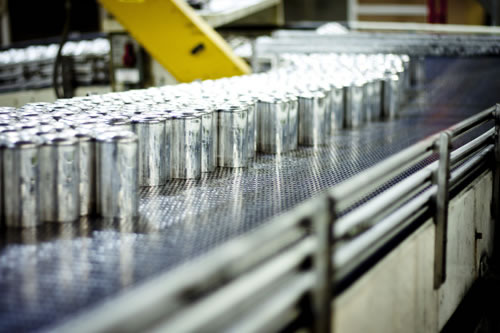
Crown Beverage Packaging’s 115 employees make 1.5 billion beverage cans each year from recycled aluminum. They have been part of Olympia since 1959.
Over the next 20 years, Olympia must continue to make judicious "up-front" investments that bring development to targeted areas, using its partnerships as effectively as possible. To keep them affordable, such investments will need to be located in the downtown, Investment Strategy Report opportunity areas or Urban Corridors. Projects that "leap-frog" to remote sites outside of our existing infrastructure can be prohibitively expensive to develop.
The Investment Strategy report recommends that the City should proactively:
• Review changing market dynamics to identify new barriers and opportunities to allow the City to invest in the most market-feasible projects.
• Develop relationships with property owners and other stakeholders to learn about their interests and short-term and long-term development goals. Given the barriers to development described in the report, the City will need to establish new partnerships with property owners and developers if it wishes to achieve development in the opportunity areas that is compatible with the City’s Comprehensive Plan. Community and neighborhood stakeholders are also critical to this process.
• Continue and improve community conversations to better clarify and articulate desired development outcomes and coordinate stakeholders’ visions for development. This work would help to refine the City’s policy goals for the opportunity areas and other areas through the comprehensive planning process. Given long-term demographic shifts, the City should support higher density, infill development to achieve multiple public policy goals.
• Take advantage of opportunities when they present themselves, which may mean that the City would focus on new opportunity areas, or move forward with actions in existing opportunity areas ahead of schedule.
• Coordinate funding opportunities with other public stakeholders (the County, transit agency, the Port of Olympia, the State of Washington, others) with the City’s CFP for major infrastructure investments that move the implementation forward.
• Coordinate with planning and implementation in key opportunity areas. Some initial steps toward implementation are already underway, including the Martin Way Corridor Study and the Comprehensive Plan update. The Martin Way Corridor Study is evaluating infrastructure investments that can improve access and safety for all transportation modes, and spur higher density development. The City could consider combining subarea planning efforts with the comprehensive planning process for the Kaiser/Harrison and Division/Harrison areas.
In addition to the City’s work on the Community Renewal Area Olympia has recently established a Section 108 Loan Program. This program leverages the City’s annual CDBG Allocation to create a loan pool to promote economic development opportunities within our community. These funds must be used in a manner consistent with the Department of Housing and Urban Development’s regulations. Generally these funds can be used to support economic development projects that create jobs for low to moderate income people or support reinvestment in areas such as downtown where low to moderate income people live.
Economic development efforts must be consistent with growth management goals and not strain the capacity of our natural resources. They must be consistent with the efficient and appropriate use of land. The impact of new business must not compromise the local environment. While growth can improve a community’s quality of life, economic development must be carefully planned. Our investment today in new buildings and streets should not damage the ability of future generations to meet their needs.
Goals and Policies
PE1.1Provide a desirable setting for business investment and activity.
PE1.2Develop or support programs and strategies that encourage living-wage jobs.
PE2.1Encourage retail, office, medical and service activities for their value in providing employment and tax revenues.
PE2.2Identify major revenue-generating sectors and identify actions the City can take to help maintain their economic health.
PE2.3Ensure that the total amount of land planned for commercial and industrial uses is sufficient for expected demand.
PE2.4Diversify the local economy in a way that builds on our stable public sector base, and by supporting businesses that can reduce reliance on goods and services from outside the community.
PE2.5Encourage employers to export goods and services to regional, national or international markets, but keep jobs and dollars in Olympia.
PE2.6Regularly review the development market to identify changing circumstances that create barriers or opportunities for investment in our community.
PE2.7Use the City’s Section 108 Loan program to promote economic investment and job creation and redevelopment activity that benefits low to moderate income people in our community.
PE3.1Support a safe and vibrant downtown with many small businesses, great public places, events, and activities from morning through evening.
PE3.2Support lively and active downtown parks and waterfront attractions.
PE3.3Promote high-density housing downtown for a range of incomes.
PE3.4Protect existing trees and plant new ones as a way to help encourage private economic development and redevelopment activities.
PE3.5Support continuation of the Dash Shuttle as a means of linking the Capital Campus and downtown.
PE3.6Use tools such as the Downtown Project, Community Renewal Area downtown plan and other planning processes and tools to improve the economic and social health of downtown.
PE4.1Plan our investments in infrastructure with the goal of balancing economic, environmental and social needs, supporting a variety of potential economic sectors, and creating a pattern of development we can sustain into the future.
PE4.2Stimulate and generate private investment in economic development and redevelopment activities as recommended in the Investment Strategy Report.
PE4.3Make decisions to invest in public infrastructure projects after analysis determining their total costs over their estimated useful lives, and their benefit to environmental, economic and social systems.
PE4.4Consider whether the public cost of new or improved infrastructure can be recovered through increased revenues the City can expect from the private investment the improvement will attract.
PE4.5Identify and take advantage of infrastructure grants, loans, and other incentives to achieve the goals of this Comprehensive Plan.
PE4.6Economic uncertainty created by site contamination can be a barrier to development in downtown and elsewhere in our community; identify potential tools, partnerships and resources that can be used to create more economic certainty for developments by better characterizing contamination where doing so fulfills a public purpose.
PE4.7Identify where new and upgraded utilities will be needed to serve areas zoned for commercial and industrial use, and encourage the development of utilities to service these areas.
PE4.8Investigate the feasibility of the City providing telecommunications infrastructure, high speed internet connectivity or other new forms of infrastructure.
PE4.9Collaborate with public and private partners to finance infrastructure needed to develop targeted commercial, residential, industrial, and mixed-use areas (such as Downtown Investment Strategy Report opportunity areas and along Urban Corridors) with water, sewer, electricity, street, street frontage, public parking, telecommunications, or rail improvements, as needed and consistent with the Comprehensive Plan.
PE4.10Encourage new development in areas the City has designated for infill before considering proposals to expand land-use areas, or adding new ones.
PE4.11Serve sites to be designated for industrial or commercial development with required utilities and other services on a cost-effective basis and at a level appropriate to the uses planned for the area and coordinated with development of the site.
PE4.12Avoiding building lengthy and expensive service extensions that would cost more than could ever be recovered from revenues.
PE5.1Maintain the City’s high quality customer service and continuously seek to improve it.
PE5.2Use regulatory incentives to encourage sustainable practices.
PE5.3Improve the responsiveness and efficiency of the City’s permit system, in part by identifying and removing waste, lack of clarity, duplication of efforts and other process inefficiencies that can occur in the development review process.
PE5.4Create more predictability in development review process to reduce costs, without eliminating protections.
PE5.5Eliminate redundancy in review processes, and create clearer rules.
PE5.6Create a review process that is easy for all parties to understand at every stage and that invites input from affected parties as early as possible in the development process.
PE5.7Use tools such as Form Based Codes, Subarea Plans, Focus Area Plans, Community Renewal Area planning and other proactive planning processes and tools to define and develop a shared redevelopment vision for specific areas within the community such as those identified in the Investment Strategy Report and elsewhere in this plan.
PE6.1Support appropriate economic development efforts of our neighboring jurisdictions, recognizing that the entire region benefits from new jobs, regardless of where they are.
PE6.2Collaborate with neighboring jurisdictions to develop a regional strategy for creating a sustainable economy.
PE6.3Look for economies of scale when providing services at the regional level.
PE6.4Prepare preliminary studies for priority development sites (such as Downtown, Investment Strategy Report opportunity areas or Urban Corridors) in advance, so the City is prepared for development applications, and the process can be more efficient.
PE6.5Collaborate with local economic development organizations to create new and maintain existing living-wage jobs.
PE6.6Work closely with state and county governments to ensure their offices and facilities are in the City of Olympia, which is both the state’s capitol and the county seat. Continue to work with the State of Washington on its Preferred Leasing Areas Policy and collaborate with Thurston County government to accommodate the needs for county courthouse-related facilities.
PE6.7Collaborate with The Evergreen State College, St. Martin’s University, and South Puget Sound Community College on their efforts to educate students in skills that will be needed in the future, to contribute to our community’s cultural life, and attract new residents.
PE6.8Encourage The Evergreen State College, St. Martin’s University, and South Puget Sound Community College to establish a physical presence in downtown.
PE6.9Collaborate with hospitals and other health care providers to identify actions the City could take to support their role in ensuring public health and their vitality as a major local employment base and to establish a physical presence in downtown.
PE6.10Work with the Thurston Economic Development Council to identify businesses that support the health care sector, and identify what the City can do to help them to succeed.
PE6.11Support our neighboring jurisdictions in their role as the regional center for other activities, such as manufacturing, freight transportation, and air transportation.
PE6.12Collaborate with the Port in its role of facilitating economic development, while continuing to exercise regulatory control over Port development and operations.
PE6.13Balance the Port’s need for truck and rail transportation corridors, while minimizing conflicts with other traffic needs and land use goals.
PE6.14Coordinate funding opportunities with other public stakeholders (the County, Intercity Transit agency, the Port of Olympia, the State of Washington, Olympia School District, others) with the City’s CFP for major infrastructure investments to maximize the impact of those investments.
Community and Economy
Several recent studies suggest that a sense of “place” – a sense of authenticity, continuity and uniqueness – is the key to a community’s future economic opportunity. One study found that cities in which residents reported highest levels of attachment to and passion for their communities also had the highest rates of economic growth over time. These studies also discovered that qualities such as a welcome and open feeling, attractiveness, walkability, and a variety of social events and venues all contributed to this emotional bond. Parks and trees, community and historic landmarks, and public art also contributed to that hard-to-define “sense of place.”
In 2009, Olympia was selected as one of the Top 10 Best Cities in the nation, by Kiplinger’s Personal Finance Magazine. While identifying state government as the “keystone of Olympia’s economy,” it called Olympia itself a "cultural diamond in the rough" where a thriving visual and performing arts scene is celebrated. It is our individuality as a community -- and our quirkiness -- that sets us apart from other communities, and which makes Olympia such a great place to live and start a business.
According to the 2011 Thurston County Creative Vitality Index, more than 650 "creative jobs" were added to the community between 2006 and 2009. These include public relations specialists, writers, librarians, photographers, architects, and others in "creative occupations."
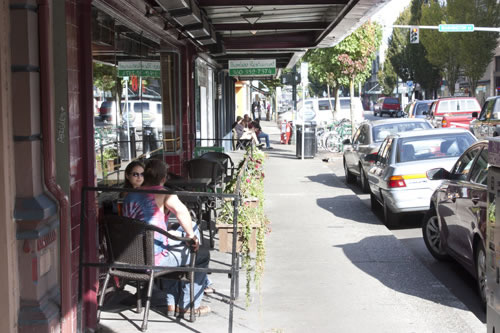
Downtown Olympia’s shops, restaurants and theaters are a draw for residents and visitors alike.
Olympia has received many awards for livability over the years. In 2010, Olympia was recognized as the most secure mid-sized city in the U.S by Farmers Insurance, based on factors that included crime statistics, weather, risk of natural disasters, housing depreciation, environmental hazards, and life expectancy. In 2010, the Gallup-Healthways Well-Being Index ranked Olympia in the top 20% of cities in Washington State. Its survey categories included life evaluation, emotional health, physical health, healthy behaviors, work environment, clean water, and general satisfaction with life and work.
Those same qualities that contribute to the strong emotional bonds many residents form with Olympia also appeal to visitors. Visitors contribute to our economy by shopping, dining, taking in a performance in one of our theaters, and spending the night in a hotel. According to the Thurston Visitor and Convention Bureau, in 2013, Thurston County businesses received an estimated $250 million from visitor spending. This activity generated an estimated $19 million in state and local taxes that year, and employed an estimated 3,000 people.
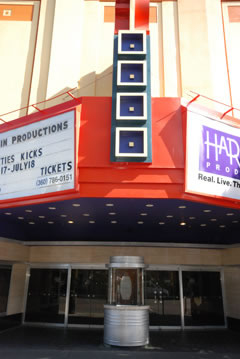
According to the Thurston County Creative Vitality Index, Performing Arts revenue grew 1.4% between 2008 and 2009.
Olympia’s arts community is also a draw for tourism, and one of its beneficiaries.
Music
According to findings from a study completed by students at The Evergreen State College for the Olympia Arts Commission, the music industry in Olympia generated an estimated $27 million in total business revenues --including manufacturing, retail, and venue receipts-- in 2008, contributing approximately $2.5 million in local and state taxes for that year.
Theater
The Arts Alliance of Downtown Olympia determined that in 2009, local theaters brought 167,000 people downtown to attend more than 500 live performances, primarily in the evenings and Sunday matinees. The industry had a $3.8 million operating budget, and brought in an estimated $1.6 million to the community in local pay and benefits.
Artists as business owners
As of January 2010, State Senate District 22, which includes Olympia, was home to 410 arts-related businesses that employed 1,374 people, according to a report published by the national organization, Americans for the Arts. According to the report, "’Arts-centric’ businesses play an important role in building and sustaining economic vibrancy. They employ a creative workforce, spend money locally, generate government revenue, and are a cornerstone of tourism and economic development."
Small businesses
According to the Thurston Economic Development Council, an estimated 14,000 small businesses are registered in Thurston County, and 92% of them employ 10 or fewer people. Small businesses include service providers, small manufacturers, farmers, artists, and many of the retail businesses that set our community apart from others.
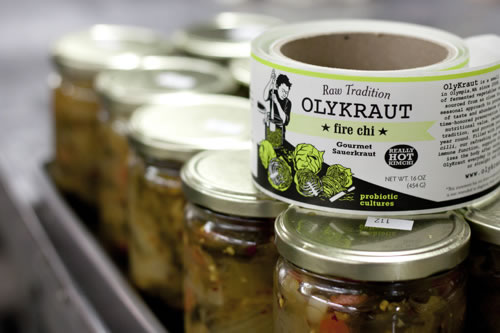
Olykraut is a small artisanal company, turning local produce into value-added product since 2008.
In order for these businesses to provide a living wage [for their owners and employees], they need a strong customer base. Since 2007, the Olympia-based volunteer organization, Sustainable South Sound has hosted a “Buy Local” program, which encourages community members to shop at local farms and businesses. The program has an education and outreach program that shows people where their dollars go, based on where they shop, and a savings book with incentives to shop at more than 140 participating farms, businesses and organizations. They also help businesses find local sources for the goods and services they need for their own operations. Business training and support is available through our local colleges and university, the Thurston Economic Development Council, and Olympia-based Enterprise for Equity, which helps people with limited incomes start and sustain small businesses.
Goals and Policies
PE7.1Actively promote economic activities that are consistent with the values expressed in this Comprehensive Plan.
PE7.2Market Olympia’s advantages to local and out-of-town businesses that may be considering expansions or new facilities in the area.
PE7.3Define a more active City role in stimulating development, and influencing the design and type of development.
PE7.4Continue to coordinate and partner with the Thurston County Economic Development Council to promote Olympia’s economic redevelopment opportunities.
PE8.1Strengthen economic vitality by helping to stabilize and improve property values in historic areas through the continued support of the Heritage Commission and planning to protect and promote our historic resources.
PE8.2Encourage new development to harmonize with existing historic buildings and areas.
PE8.3Protect and enhance the City’s ability to attract tourists and visitors through preservation of historic resources.
PE8.4Renovation, reuse and repair of existing buildings is often preferable to new construction and should be done in a manner that protects and enhances the resource when historic properties are involved.
PE8.5Help low- and moderate-income individuals rehabilitate their historic properties.
PE9.1Provide or support, services and facilities to help visitors enjoy our community’s special events and unique character, and work to fully capture the potential economic benefits of their visits.
PE9.2Continue to support efforts to restore, maintain and improve Olympia’s local museums and other attractions.
PE9.3Support continued tree plantings as a way to continually improve on Olympia’s natural beauty and attractiveness to tourists – and to help create a network of scenic roadways and streets.
PE9.4Implement strategies to enhance heritage tourism opportunities.
PE10.1Continue to provide programs and services that support visual and performing arts activities in Olympia.
PE10.2Support local art galleries, museums, arts and entertainment facilities, live music venues, arts organizations, and businesses.
PE10.3Examine the feasibility of establishing an arts center for the community.
PE11.1Promote the concept that buying from local businesses is a way to strengthen the local economy.
PE11.2Provide support for start-up businesses. Develop local awareness of the need for business incubator facilities, and allow for more home-based businesses.
For More Information
• Knight Soul of the Community Project studies that sense of "place" that attached people to their communities
• Port of Olympia Comprehensive Scheme of Harbor Improvements
• Port of Olympia 2013-2025 Strategic Plan Vision 2025
• The Profile is the Thurston County Regional Planning Council’s flagship document that provides demographic, statistical and mapping information
• Thurston Economic Vitality Index provides both a trend analysis and snapshot of Thurston County’s economy based upon a series of key indicators
• Washington State County Travel Impacts 1991-2009 examines the economic significance of the travel industry in the 39 counties of Washington state from 1991-2009
• Investment Strategy – City of Olympia Opportunity Areas
• Downtown Olympia Community Renewal Area Feasibility Study
• Poverty in America Living Wage Calculator
1Source: Washington Department of Personnel, 2013
1Thurston County Employment Forecast Allocations, 2013: Thurston Regional Planning Council


